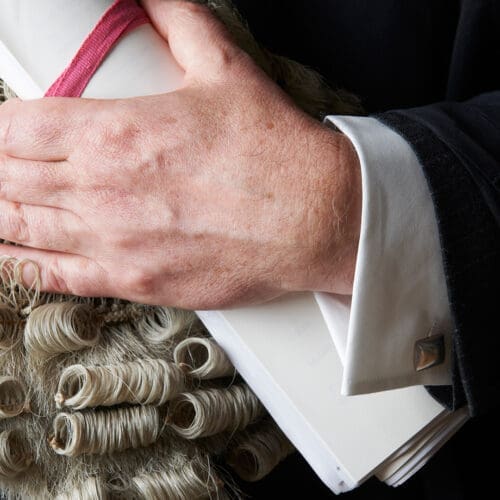Lee Witcomb v J. Keith Park Solicitors [2023] EWCA Civ 326 Section 14A Limitation Act 1980 – what knowledge is required?
April 2023Introduction
The introduction of s14A Limitation Act 1980 (‘s14A’) was prompted by obvious injustice; claims where the claimant could only have discovered the possibility of a claim at a time when the primary six-year limitation period had already expired. For many of us, it is now difficult to comprehend that prior to 1986 a claimant in that situation would have no remedy.
Cases of such obvious injustice have naturally disappeared following the introduction of s14A, but the true scope of what is a relatively complex provision continues to exercise the courts. This is particularly relevant in claims against professionals given the propensity for losses arising from allegedly negligent professional advice to arise only several years later.
Background
C was injured in a road accident in July 2002, suffering serious injuries to his right leg. Proceedings were issued against the driver and liability was admitted, but there was a dispute about quantum. C was advised by his solicitors (D) that a lump sum payment in full and final settlement of his claim was the only option available. At the time of settlement C was aware that he would need substantial further treatment. For example, in December 2009 he was told he would likely develop osteoarthritis by 2013-18. On 14 December 2009, just two days prior to settlement, C was further advised that once osteoarthritis developed he would be offered further surgery.
At a settlement meeting on 16 December 2009, the driver made a final offer of £150,000 and C was advised that there was a risk of not beating the offer at trial and becoming liable for costs. C was advised by D that settlement was being offered on a “once and for all” basis, and therefore if after surgery to remove metalwork (which would be necessary in due course), it was discovered that he had a more serious injury than was appreciated, he could not recover further damages. C did not wish to delay settlement and to seek a stay pending further surgery, because he did not know when the future would become clearer, he wanted to achieve certainty of settlement and D had in any event advised him that it was unlikely the court would stay the proceedings in such circumstances. C therefore accepted the offer of £150,000 in full and final settlement. He had received no advice about the possibility of provisional damages.
In the event, C’s condition deteriorated much more quickly than anticipated. Shortly after settlement, C began suffering severe pain in his ankle due to osteoarthritis, ie around 4-9 years earlier than had been estimated. By July 2016 the pain had become unbearable, and in September 2016 it was suggested C might undergo joint fusion (which had also been anticipated, but only 10-20 years later). Due to potential difficulties with that procedure caused by the skin grafts, C was first referred to a plastic surgeon, and it was in consultation on 19 January 2017 that below-knee amputation was considered (and recommended) for the first time. On 27 January 2017, C emailed D and asked if there was any possibility of reopening his case against the driver as the possibility of amputation was not factored into the original claim. On 3 February 2017 D advised that the settlement could not be reopened.
C was later advised by a doctor to seek further legal advice, which resulted in C issuing proceedings against D on 17 December 2019, ten years after the settlement agreement and four years outside of the six-year limitation period. C sought to rely on s14A. The primary allegation of negligence was failing to advise C to seek provisional damages in his original claim, leaving it open to him to seek further damages if his condition worsened unexpectedly. It was C’s case that he only reached a “once and for all” settlement in 2009 in his particular circumstances because he was simply not advised that the legal system afforded an alternative solution (since 1985 when provisional damages were introduced by the Senior Courts Act 1981).
The law
The primary limitation period for a claim in negligence is six years running from when the cause of action accrued. S14A provides an alternative period of three years from the ‘starting date’ defined in s14A(5) as: “the earliest date on which the plaintiff … first had both the knowledge required for bringing an action for damages in respect of the relevant damage and a right to bring such an action”. It is further clarified in s14A(6) that “the knowledge required for bringing an action for damages in respect of the relevant damage” means knowledge both:
(a) “of the material facts about the damage in respect of which damages are claimed” [defined in ss14A(7): “the material facts about the damage are such facts about the damage as would lead a reasonable person who had suffered such damage to consider it sufficiently serious to justify his instituting proceedings for damages against a defendant who did not dispute liability and was able to satisfy a judgment”] and
(b) “of the other facts relevant to the current action mentioned in subsection (8) below” [which so far as relevant are “(a) that the damage was attributable in whole or in part to the act or omission which is alleged to constitute negligence…” ]
First instance
Following trial of the limitation point as a preliminary issue in 2021, the Judge concluded that C had knowledge of the material facts (ie under s14A(6)(a) and (7)) – that his injuries were much more serious than expected) in mid-2016, but that he only had knowledge of attribution (ie the requirement in s14(A)(8a): that the damage was attributable in whole or in part to the act or omission which is alleged to constitute negligence” ) at some stage after January 2017, which on any view was less than three years before proceedings were issued. The claim was brought in time and would be allowed to proceed.
The appeal
D’s appeal was unanimously dismissed by the Court of Appeal.
The grounds of appeal were twofold: (1) the Judge should have concluded that C in fact had knowledge of both the material facts about the damage, and of attribution, on the date the settlement was reached in 2009, and (2) having determined that C in fact had knowledge by mid-2016 of his more serious than anticipated injuries, the Judge was wrong to find that C did not acquire knowledge of attribution until at least 19 January 2017.
On the issue of material facts, D’s case was that as at 16 December 2009 C knew i) that he was suffering from ongoing symptoms from the accident and that there were risks he would suffer further symptoms in the future; ii) that he could not claim further compensation in respect of further symptoms suffered in future or any additional treatment he may require; and iii) that D had not advised him that he could or should seek or obtain a settlement or order entitling him to seek further compensation in respect of future symptoms. It was the third of these propositions with which the Court of Appeal took issue, the assertion that C ‘knew’ that D had not advised him that he could or should seek an entitlement to further compensation in respect of future risks, was an artificial framing of C’s position. Rather, C did not know that there was any alternative to a single payment in full and final settlement, or any option of protecting against future risks by way of provisional damages. To say that C knew that he had not been advised as to the possibility of protecting against deterioration in his condition was artificial and wrong; he did not know that any such possibility existed.
Further, subsections 14A(6)(a) and (7) are satisfied if a claimant knows such facts about the damage as would lead a reasonable person who had suffered such damage to consider it sufficiently serious to justify his instituting proceedings, even if they do not know the full extent of the damage. D further submitted that it was irrelevant that C did not know in December 2009 of all the possible further symptoms he could suffer or all the treatment he may require, as that was merely knowledge of the full extent of the damage; D submitted that C knew of some of the damage and that was sufficient. However, that submission was also wrong; whilst D was aware of the possibility of an under-settlement of his claim if his injuries turned out to be worse than feared, the “damage in respect of which damages are claimed” was not the risk of under-settlement on that basis at all, but rather the absence of a claim being advanced for provisional damages. The former type of damage would be relevant if C’s claim was about the negligent assessment of the quantum of his claim at the date of settlement, but not to the claim for negligence arising out of the failure to advise in respect of provisional damages: “The absence of the claim for provisional damages is the essential material fact about the damage of which the claimant had no knowledge”. Applying s14A(6)(a) and (7), as at December 2009 C knew nothing about the damage that would justify his instituting proceedings (ie proceedings in respect of the failure to advise as regards provisional damages).
As to the question of attribution in s14A(8), the decision rested to a large extent on the decision of the House of Lords in Haward v Fawcetts, that “time does not begin to run against a claimant until he knows there is a real possibility his damage was caused by the act or omission in question”, with ‘caused by’ being the key words. It was not sufficient for the claimant in that case to know that he had received advice from the defendant, that he had relied on that advice and that as a consequence he had lost money. A claimant must also know there was a “real possibility” that the damage was caused by (‘attributable to’) the acts or omissions alleged to constitute negligence, and the conduct alleged to constitute negligence was not the mere giving of advice, but the giving of flawed advice: “This feature is the very essence of Mr Haward’s claim. Stated in simple and broad terms, his claim is that Mr Austreng did not do his job properly. Time did not start to run against Mr Haward until he knew enough for it to be reasonable to embark on preliminary investigations into this possibility”. Adapting that analysis to a case of the present nature, the Judge had found that C had no reason to suspect that D had not done its job properly, ie that there had been flawed advice or flawed omissions from the advice, before 2017. When his condition worsened in 2015 and 2016, he was experiencing precisely the kind of post-operative problems which his advisers themselves had referred to in 2009 when they had properly identified the risk of under settlement if his condition was worse than feared. That was not a reason for C to consider that he might have been wrongly advised. Similar points could be made in respect of the position in January 2017 when the possibility of amputation was first mentioned (it might if anything have prompted concerns about the original medical opinion, not the legal advice). In any event, it was not necessary to decide the precise date on which C obtained the relevant knowledge once it was accepted that it was not before January 2017, as proceedings had been issued within three years of that point.
Comment
The decision reemphasises the difficulties of assessing cases which may fall on the borderline in relation to the application of s14A, although whether this is a borderline case may itself be open to debate. It might have been a more difficult decision had the events of January 2017 happened earlier, at a time when it would have been necessary for the Judge to determine when in fact knowledge was obtained. Of note, the parties seemingly did not challenge the first instance Judge’s decision that ‘material facts’ knowledge (ie knowledge other than of attribution) was obtained in mid-2016, but it is difficult to see on what basis that can have been correct given the way in which the Judge and the Court of Appeal analysed the relevant ‘damage’ – namely the failure to include a claim for provisional damages – which C could not have known about until at least January 2017.
In any event, the decision demonstrates the need in each case to carefully consider what knowledge a claimant has acquired – or ought reasonably to have acquired – and by when, and how that should be applied to the detailed provisions of s14A. Drawing broad conclusions from the point at which ‘something has gone wrong’ which the claimant should investigate further, will not always be appropriate, as the way in which the statutory provisions have been interpreted by the courts requires a forensic analysis of the exact nature of what was known and, as emphasised by this case, whether it is knowledge “about the damage (in respect of which damages are now claimed)” and whether it comes with knowledge that the damage has been caused by (and is not merely connected to) the act or omission of the defendant.
There is an instructive comparison to be made with another case relied on by D, Boycott v Perrins Guy Williams [2011] EWHC 2969. In that case, the claimant bought a property for him and his girlfriend to live in, as joint tenants so that if one of them died the survivor would own the property. The solicitor defendants did not explain that either joint tenant could unilaterally sever the joint tenancy. 11 years after the purchase the girlfriend, who was then very ill, served notice to sever the joint tenancy, so her share of the property passed to her estate and not the claimant. The claimant was advised by different solicitors that the notice was effective, but they said nothing about the defendants’ original advice. Nevertheless, the judge held that the claimant had knowledge by the time he was advised by the second solicitors that the notice was effective. The key difference between that case and this would appear to be that C had not been advised as to the possibility of provisional damages, but that C only became aware of that omission at the point where he became aware that provisional damages would have been an option. In Boycott, whilst the claimant had not been advised about the severability of the tenancy, his subsequent awareness of the possibility that the advice was flawed came at the point when the tenancy had in fact been severed, that the severance was valid and at which point he lost his anticipated ownership rights. He must at that point have known that the original solicitors had not carried his wishes into effect.
Download PDF








